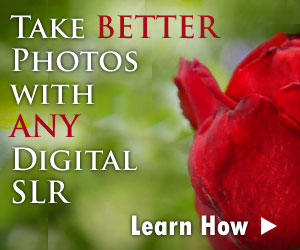RAW vs. JPG
If you've been doing your digital SLR homework, you've probably read some debate about the merits of RAW vs. JPG.
While it sounds like it might be the final match in an evening of professional wrestling, it really describes the two different ways you can capture photos with a digital SLR.
Let's simplify the issue for a moment.
There's really only one basic question you need to answer: do you want the camera to process your images or not?
In the paragraphs that follow, I'll explain why having an anwer to this question will help you select the right format to use.
RAW? JPG? What ARE these?
RAW and JPG refer to the two different file types your camera can produce.
Whenever you use a computer program, it creates a file type that can often only be opened by that program.
For example, MicroSoft Excel creates XLS files, while Word creates DOC files. Adobe Photoshop saves files called PSDs.
All acronyms aside, it's sufficient to understand that RAW and JPG are two fundamentally different file types.
RAW Defined
RAW files are aptly named in an odd sort of way, since most of us are more familiar with another definition of "raw": uncooked.
A RAW file is the unedited image data that you digital SLR camera captures every time you take a photo.
So you could say that a RAW file is an "uncooked" digital photo.
The camera does not manipulate the image in any way before it is saved on the memory card.
A RAW file is a pure capture, and is equivalent to a digital negative - an unprocessed image that you can adjust to your heart's desire before you make a print.
JPG Defined
Unlike a RAW file, a JPG is a processed image. All of the processing takes place inside the camera before the camera saves the photo onto a memory card.
Here's just some of the processing that takes place:
- Color Saturation - an increase or decrease in the intensity of colors
- Sharpness - can make the image either looks crisp or soft
- Contrast - affects the range between shadows and highlights
When you capture digital images as JPG files, it's as if the camera has "developed" them first. This comes with a drawback:
The processing that an SLR applies to a JPG image can't be undone.
This doesn't mean that you can't make further changes to your photo in an image editing program after you take it - you certainly can.
It just means that any color or exposure settings applied when the photo was taken can't be altered after the fact.
Image Compression
A digital image is made up of millions of tiny dots called pixels and a camera has two options when it comes to the color of these pixels:
- Leave them the way they were captured by the camera's sensor
- Adjust ones with similar color so that they are identical
When pixels that are very similar in color are all made identical, this reduces the overall file size of your digital photo.
This is the effect of mild compression - severe compression can drastically reduce the overall quality of the image, producing photos that look unsharp and blocky.
Image compression is applied to every JPG file in some amount (you control the severity of the compression using camera settings) — by contrast, no compression is used for RAW files.
The Differences
Now the real fun can begin.
We're going to talk about the pros and cons of each file type, and why you might be more inclined to use one or the other.
Pros and Cons of JPG
| Pros | Cons |
|
|
JPG is by far the easier format to work with.
Since JPG is a standard file format on every type of computer (even really old ones), JPG files can be viewed by anyone.
Even if you don't own an image editing program, you can still view your JPG images by using standard utilities already built into your computer.
Since every JPG is compressed, it doesn't take up as much space — this also means that it takes significantly less time to upload a JPG to an online gallery to share with friends.
All this ease of use comes with one major drawback that - in the end - may be of no concern to you at all.
When set your camera to capture photos as JPG files, you are letting the engineers who put your camera together decide how your final images are going to look.
Decisions about the color, tone and clarity of the photo are not under your direct control - that's all decided for you.
If you take a portrait and decide after the fact that you don't like the skin tones or capture a beautiful sunset but the colors don't pop quite as much as you'd like, there's little that you can do about it. The image is (somewhat) set in stone.
Pros and Cons of RAW
| Pros | Cons |
|
|
The long list of cons is the primary reason why most folks avoid RAW files completely and just stick with JPG.
First, RAW files are huge: relative to JPGs, they eat up a lot of memory on your camera's card and on your computer's hard drive.
A RAW file can use up to 4 times as much digital "space" as a JPG.
Example: a very high-quality JPG image might use up 6.4 MegaBytes of space. The same image captured in the RAW format can take up to 24 MegaBytes of space.
These enormous file sizes can impact those who want to work with RAW:
- You need memory cards with more storage space (if you want to take any reasonable number of images per shoot)
- You need plenty of clear hard drive space
- It takes extra time to transfer images from memory card to hard drive
- You need a pretty powerful computer if you want to view and edit these huge files
On the plus side, memory today is very cheap. You can pick up a nice big 4 GigaByte Compact Flash card for about $40 while an 8 GigaByte SD Memory card will run you about $20.
You can also get a 500 GigaByte hard drive (which would allow you to store about 25,500 RAW files) for less than $100.
Getting a new computer just so you can edit RAW files can be the most expensive part of this equation, but if you've purchased a new machine any time within the past 2 to 4 years, it should be able to handle the load.
Once you've got all the storage space set up, you're going to need a special program to even see what your RAW photos look like.
RAW image files are unique to each camera manufacturer: so a RAW file produced by a Canon digital SLR won't be the same as a RAW file produced by a Nikon.
Since each camera produces a slightly different file format for RAW, there are only a handful of programs that can interpret them:
- Adobe Elements ($80)
- Nikon Capture ($110)
- Bibble 4 Pro ($120)
- Apple Aperture ($160)
- Adobe Lightroom ($280)
So: RAW files are huge AND they require specific software to view and edit.
What's the point of all this? It's actually pretty powerful: you can manipulate any part of your digital image AFTER the photo has been taken.
Don't like the exposure? Change it. Not happy with the color? Change it. Feel the image is too sharp or too soft? You get the idea.
You can even fix flaws in the image that are created by the lens that you have attached to the camera.
The image editing possibilities with a RAW file are virtually endless, and this gives you an immense amount of control over how all your photos look.
The best part: you can correct mistakes you make at the time of exposure (but you NEVER make mistakes, right?).
Let's say that you've been fiddling around with your camera's exposure settings, and are suddenly faced with a prime photo opportunity. You don't pay attention to the settings and over-expose a few key frames.
If you were taking photos as JPGs, those images would be lost: there would be no way to correct the over-exposure.
But with RAW files, correcting an over-exposed image is a simple as moving a slider to adjust the way the image looks.
Take the following two photos: the image on the left is the exposure as I captured it (way over-exposed and too far away). The image on the right is the exact same photo, only with corrections applied using a RAW image editor. Big difference.
 |
 |
The Professional's Choice
Many professional photographers only shoot RAW files and would never dream of using JPG images.
Keep this important fact in mind: photography is their job.
Since it is a full-time job, they can devote the hours it takes to process and edit RAW images so that they have complete control over the photo from start to finish.
They already have special software that allows them to process RAW files, and the computer power to manipulate them. They also understand how levels, curves, color saturation and hue can alter their photos and can make minute adjustments to each one of these.
If all those terms I just listed sound like jibberish to you, you'll have a lot to learn when it comes to processing RAW images.
In the end, using RAW files is all about control.
If you're the sort of person who always dreamed of developing your own film, then RAW is the perfect choice. You can make each photo look exactly the way you want it to.
On the other hand, if you enjoy taking photos much more than manipulating them after the fact then JPG is a much better option.
Buying Tip
Every digital SLR camera can capture photos as both RAW and JPG files...so for once, there's nothing for you to decide!
| Digital SLR Home |

|



